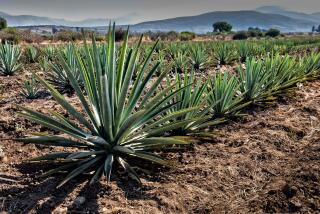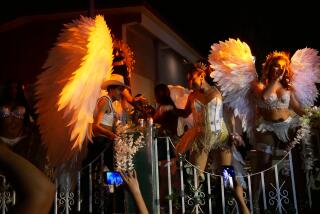Oaxacan festival moves to Eastside in bid for wider audience
Long isolated and discriminated against in their native Mexico, L.A.’s Oaxacan Indian community is trying to reach out to America.
The group is moving its annual festival, known as the Guelaguetza, from Pico-Union near downtown to Lincoln Park on the Eastside. It’s a small change — a matter of just a few miles — but one that the festival’s Oaxacan organizers say shows their eagerness to break out of their insular world.
“It’s not an area [Oaxacan] people know. In East L.A., it’s Hispanic, but not Oaxacan,” said Arturo Aguilar, a baker who has participated in the festival for the last 10 years. But “we need to open ourselves to everyone — Oaxacans and non-Oaxacans.”
In Mexico, northerners have long disdained the shorter and darker-skinned Indians from southern states. That attitude has migrated to the United States along with the people.
Many Oaxacans, mostly Zapotec Indians, arrive not knowing Spanish, a language they often speak with an accent.
“Historically, there’s always been this difference between north and south,” said Mauro Hernandez, president of the Oaxacan Regional Organization, which organizes the Guelaguetza. “We’re short, darker and the northerners are whiter and taller. You feel discriminated against, that they think that because we’re darker, we don’t think.”
Most Oaxacans settled near Pico-Union, and many say they generally avoid East Los Angeles, where northern Mexicans have congregated.
Moving the Guelaguetza to the Eastside, organizers say, is a way of expanding the appeal of the festival, which will take place Sunday.
“It’s a new strategy,” Hernandez said. “We want a different public [to attend]. We have the Oaxacans. But we don’t have people who live on the Eastside, or those who live in South Pasadena or San Marino.”
The Guelaguetza, which includes food, dance, music and art, is a Zapotec Indian term for “mutual help” — a concept that is part of the communal culture of Oaxacan Indian life.
The first Guelaguetza was held in 1987 at Pico-Union’s Normandie Park. The park had become central to Oaxacan immigrant life. Large numbers of Zapotecs lived nearby, attracted by cheap housing and the basketball courts. There are an estimated 150,000 to 300,000 Zapotecs in Los Angeles.
The first Guelaguetza featured little more than music and folk dances performed before a few hundred people. It remained that way for many years, unknown to many outside the community.
But the event has grown over the years, helping to boost Oaxacan restaurants and other businesses that took part in the festival.
“You don’t make a lot” at the Guelaguetza, said Zeferino Garcia, a Oaxacan businessman and restaurant owner who got his start at the festival, “but it helps you do promotion. People get to know you. You talk with them.”
“We helped each other,” said Fernando Lopez Mateos, owner of La Guelaguetza restaurant on Olympic Boulevard in Koreatown. “As the Guelaguetza grew, the restaurants began to get on their feet.”
Aguilar began sponsoring the Guelaguetza in 2002, and set up a booth selling bread from his Vermont Avenue Valle de Oaxaca bakery in 2004. He now owns five businesses: three bakeries, a market and a handcraft store.
“The Guelaguetza is really about mutual aid,” Aguilar said. “It helps us and we help it.”
More to Read
Start your day right
Sign up for Essential California for news, features and recommendations from the L.A. Times and beyond in your inbox six days a week.
You may occasionally receive promotional content from the Los Angeles Times.






